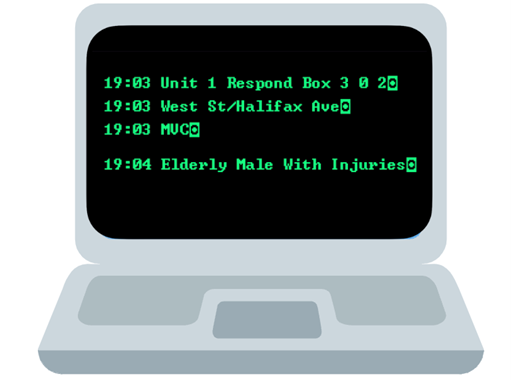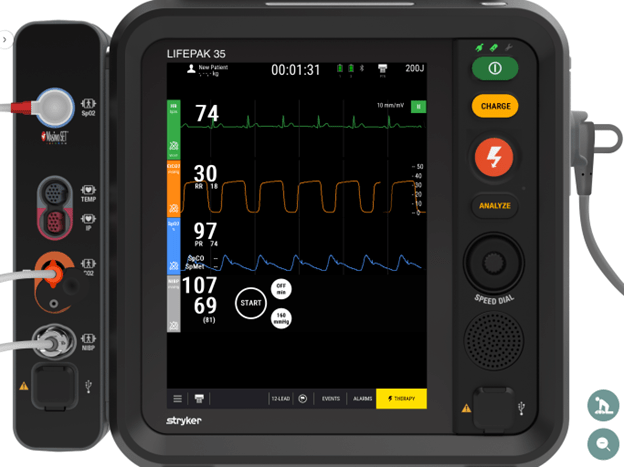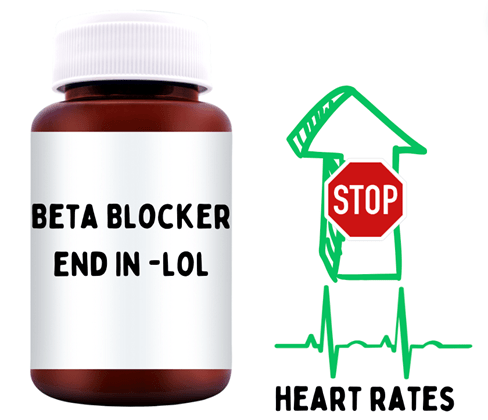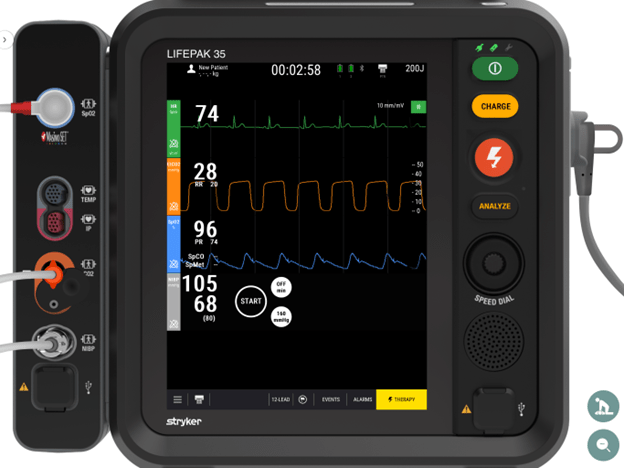
Photos provided by the author.
Nothing is better than a warm spring Friday night overtime shift with your partner of 15 years. You both have not had the opportunity to work together in quite some time and take a moment to post up with a smoothie and catch up on old times. As you dig into the new house you recently bought and the upcoming vacation you have planned, you hear the CAD chirp.

You’re dispatched to West Street and Halifax Ave. for a motor vehicle collision; you tap en route and enjoy one last sip of the refreshing strawberry smoothie. You start your way to the grocery store parking lot, and after a three-minute response, you pull into a commercial parking lot and find a large 80s-style sedan with a couple of people standing around it. It is head-on into the concrete base of a parking lot light pole. You notice the front grill is compressed, the hood is crumpled, and an elderly gentleman is standing outside talking to two other individuals, and he appears upset.
You make your way over to the patient and glance in the car, noting that the seatbelt seems loose in the vehicle as if it was worn before impact, there are no airbags because it is so old, and there is a crack on the base of the driver side windshield. The light pole is stable with damage to the paint and some chipping of the concrete.
You introduce yourself to George Hoelzen an 88-year-old male who is trying to get home with the groceries when he “bumped” the light pole. He seems jittery, anxious and embarrassed; and he is very dismissive of being injured. He wants to get the groceries home to his wife. He’s clearly moving all of his extremities and standing upright but appears pale to you. He is also rubbing his left shoulder.
You ask the bystanders if they saw him before the accident and if he was acting OK. They did see him, and he appeared to be fine in the store but was in a hurry. You asked George if it would be OK if you get him in the back of the ambulance and do a quick set of vitals before you let him go, and let him know that if everything checks out okay, you have a form for him to sign.
He reluctantly agrees and makes his way to the unit, slowly climbing up the well steps into the back of the ambulance. Your partner hooks him up to the monitor. As you continue your assessment, you recheck and confirm that he has no neck or back pain or knee, leg, abdominal pain, or head pain while palpating the areas for any abnormalities. He denies everything, and you find the following vital signs after acknowledging his very reluctant “I’m fine” statement. He intermittently holds his left shoulder but quickly stops when you look at him.

Is there anything that jumps out at you or you would want to elaborate on? You ask him if he can refresh your memory on what medications he takes and what medical conditions he has. He states his only medical history is high blood pressure, and he takes a medicine that starts with an M, but he cannot remember the name of it.

You do your best to assess his cognitive capacity with questions around today’s date, what time it is, where he is currently, what he was doing before you two met, who the president is, etc. He can rattle them all off but is slowly appearing to be fatigued. You advise him of your findings on the monitor, that you’re noticing his fatigue, and that with the tank of a vehicle he was driving. Your concern is that he may have underlying injuries that are not manifesting yet because some of his vital signs appear to be culprit of this.
He chuckles at your comment, having been an army veteran in the past, and you calling his car a tank seems to open him up to conversation. He asks you with a scouring but inquisitive tone, “What about my vital signs has you worried?” You explain that his heart rate is low, but you believe that to be the medicine he is on for his blood pressure, which is also low.
The carbon dioxide values help us discern good blood flow throughout the body and that is abnormally low. And while he is a such a spry young 88-year-old male you are worried that is an early sign of something else going on. You also ask, “Is there any chance you take aspirin or blood thinners daily, I know I’ve asked you before?” He advises he does take aspirin a day. After your continued effort and explanation about the potential medical conditions that could be brewing, George agrees to get checked with you.
His last set of vital signs are found below. The only other complaint he has is worsening left shoulder pain. You transfer care and find out later, after dropping off your next patient, that George ended up having a fractured spleen.

This is an excellent case of good assessment and using all of your tools to assess your patient. In this case, the patient’s heart rate was chemically lowered from what we would expect with internal bleeding from their daily dose of beta-blockade for their hypertension. While the accident wasn’t bad, vehicle technology has changed so much that today they “look bad.” However, by design, they are made to crumple and crunch to absorb the kinetic energy so that it doesn’t get transmitted to the passenger compartment. Older vehicles did not have that, so the energy resonates throughout the car and commonly was absorbed by the patient and their body’s impact on the area in the passenger compartment.
Capnogrpahy was our clear outlier in the “out-of-normal” vital signs. End-tidal capnography has been shown to be an early predictor of morbidity and mortality when patients present with continuous low values in the setting of disease or trauma.
Chris Kroboth has been a career paramedic/firefighter for over 17 years and in EMS for over 23. He has been in prehospital and in-hospital education for the past 18 years. His last assignment before returning to operations was as the EMS training captain in charge of continuing education programs and certification. He is also affiliate faculty with the Virginia Commonwealth University Paramedic Program. He is the U.S. clinical education manager for iSimulate and also facilitates national conference clinical challenges to include EMS World, ENA and NTI.


